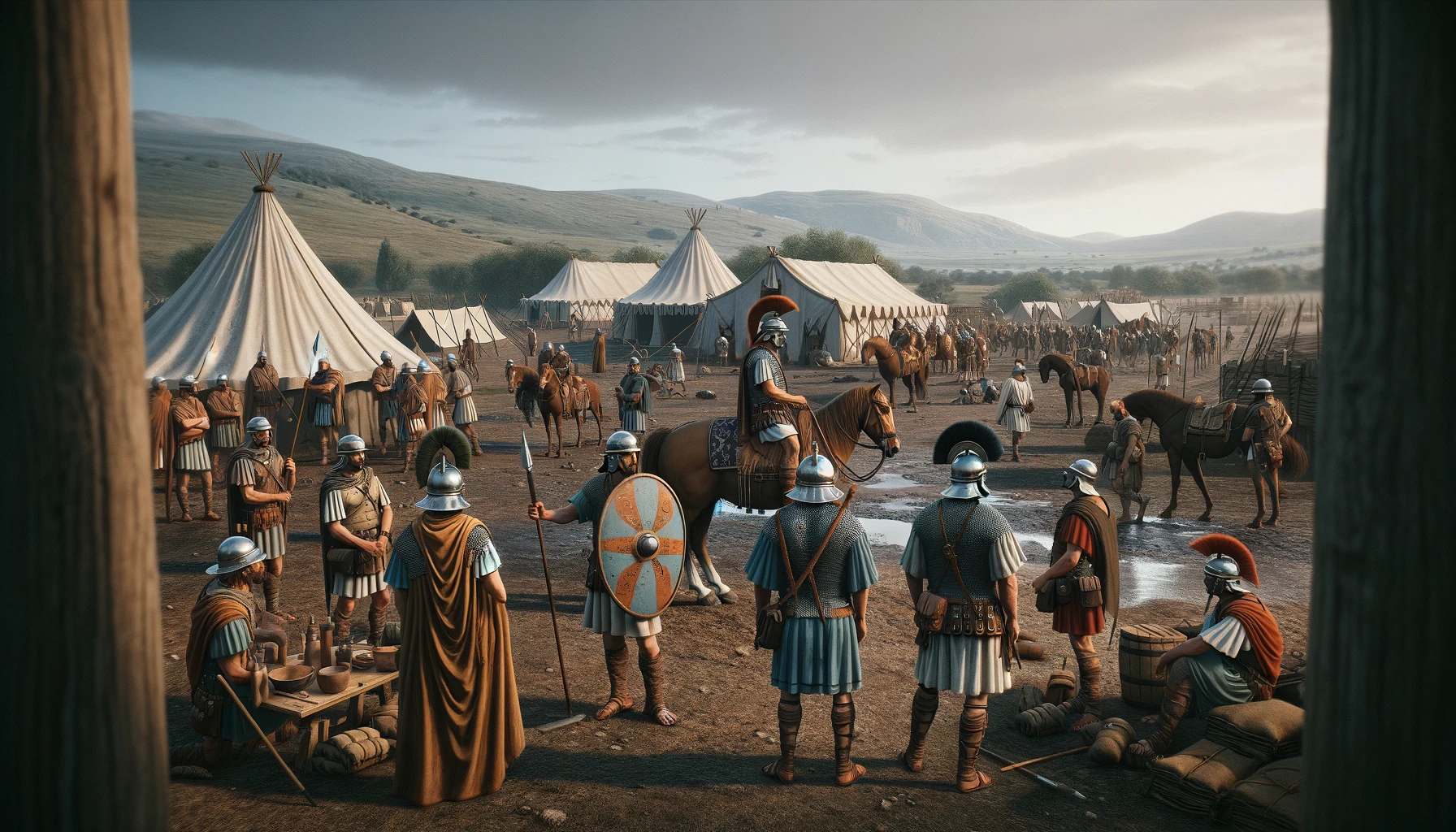Batavi Action During the Roman Invasion in 43AD
“… The barbarians thought the Romans would not be able to cross this [the River Medway] without a bridge, and as a result had pitched camp in a rather careless fashion on the opposite bank. Plautius, however, sent across some Celts who were practised in swimming with ease fully armed across even the fastest of rivers. These fell unexpectedly on the enemy, …”
Above extract from The History of Rome by Cassius Dio (LX.xx)
The Batavi were a tribe of renowned horsemen and swimmers who lived on an island between the Waal and the Rhine in the Roman province of Lower Germany. The area nowadays contains the large towns; Rotterdam, Sleidrecht, Geldermalsen and Tiel, all within the Netherlands. One of their most renowned tactics was the method they employed to cross wide bodies of water en-masse, where several foot soldiers would swim alongside a single cavalry soldier and his horse, presumably keeping their weapons above water by using the horse as a kind of living raft. Their tactics have been identified in use under Aulus Plautius during the Battle of the Medway in 43AD (vide supra) and also under the governor Gaius Suetonius Paulinus, the auxiliary troops who crossed the Menai Straits onto the Isle of Anglesey were in all likelyhood Batavian units (vide infra). It is thought that in the army of Plautius there were eight Batavian units, each five-hundred strong; Cohors I-VIII Batavorum equitata quingenaria.
Batavi Action During the Roman Invasion of Anglesey in 61AD
“… He therefore prepared to attack the island of Mona which had a powerful population and was a refuge for fugitives. He built flat-bottomed vessels to cope with the shallows, and uncertain depths of the sea. Thus the infantry crossed, while the cavalry followed by fording, or, where the water was deep, swam by the side of their horses.”
Above extract from The Annals of Imperial Rome by Cornelius Tacitus (XIV.i)
Sometime during 64AD the Legio XIV Gemina were withdrawn from Britain by the emperor Nero and stationed on the Rhine frontier; it is thought that all eight Claudian units of Batavi were removed to the continent at the same time.
When the Roman world was in upheaval during the year 69AD, among the numerous events which rocked the empire were two in particular in which the Batavians were closely involved: the revolt of the Brigantes in Britain, and the revolt of the Batavi themselves in Lower Germany under Julius Civilis, which is well documented in The Roman Histories of Cornelius Tacitus. In Britain, Cartimandua the queen of the Brigantes tribe, spurned her husband Venutius in favour of her own shield-bearer Vellocatus, and thus precipitated a Brigantian revolution throughout the north of England. The rebellion raged from coast to coast and the elderly queen had to be rescued by a force of horse and foot soldiers sent by the governor Marcus Vettius Bolanus.
One of the first acts of Vespasian upon his arrival in Rome in 70AD was to appoint a new governor for Britain, the able commander Quintus Petilius Cerialis , who had recently put down the Batavian revolt of Civilis in Germany. He was seen as the perfect choice to command the campaign against Venutius. Cohors Primae Batavorum were the first of four one-thousand strong, part-mounted units, levied from the Batavi tribe following their revolt and shipped out to Britain with governor Cerialis.
Four Cohorts of Batavi in Action at Mons Graupius
“… Agricola ordered four battalions of Batavi and two of Tungri to bring things to the sword’s point and to hand-to-hand fighting; … when the Batavi began to exchange blows hand to hand, to strike with the bosses of their shields, to stab in the face, and, after cutting down the enemy on the level, to push their line uphill, the other battalions, exerting themselves to emulate their charge, proceeded to slaughter the nearest enemies; …”
Above extract from The Agricola by Cornelius Tacitus (xxxvi.1-2)
The above passage is particularly interesting as it records the hand-to-hand fighting tactics employed by the Batavi, also the fact that in this battle against the combined Caledonian tribes all four Batavian cohorts were employed, numbering almost four-thousand Batavi warriors alone.
We know a lot about Flavius Cerialis, the prefect of the ninth cohort of Batavians, who lived with his family in the praetorium at Vindolanda between 92 and 105. His correspondence accounts for over 80 letters of the published and unpublished tablets.
His Latin name denotes the fact that he was a Roman citizen. The name Flavius strongly implies that his citizenship was acquired no earlier than AD70, and the cognomen ‘Cerialis’ might suggest some connection with Petilius Cerialis, who was instrumental in the suppression of the Batavian revolt of AD 69-70.
Evidence for the presence of Cohors Primae Batavorum equitata in Britain
- Burn 100; CIL XVI.65 military diploma dated: July 17th 122AD.
- Cil Vii.1195 privilegia militvm; dated: September 16th 124AD.
- Carvoran (RIB 1823/1824).
- Hadrian’s Wall between Castlesteads and Stanwix (RIB 2015 altar); recorded on the RBO page for Bewcastle (RIB 2015).
- Castlecary (RIB 2154 altar).
- Carrawburgh (RIB 1534 altar; 1535 altar; 1536 altar; 1544 altar 213-222AD; 1545 altar; 1553 237AD; 1559/1560 & 1562 tombstones; 1563a altar; Notitia Dignitatum).
